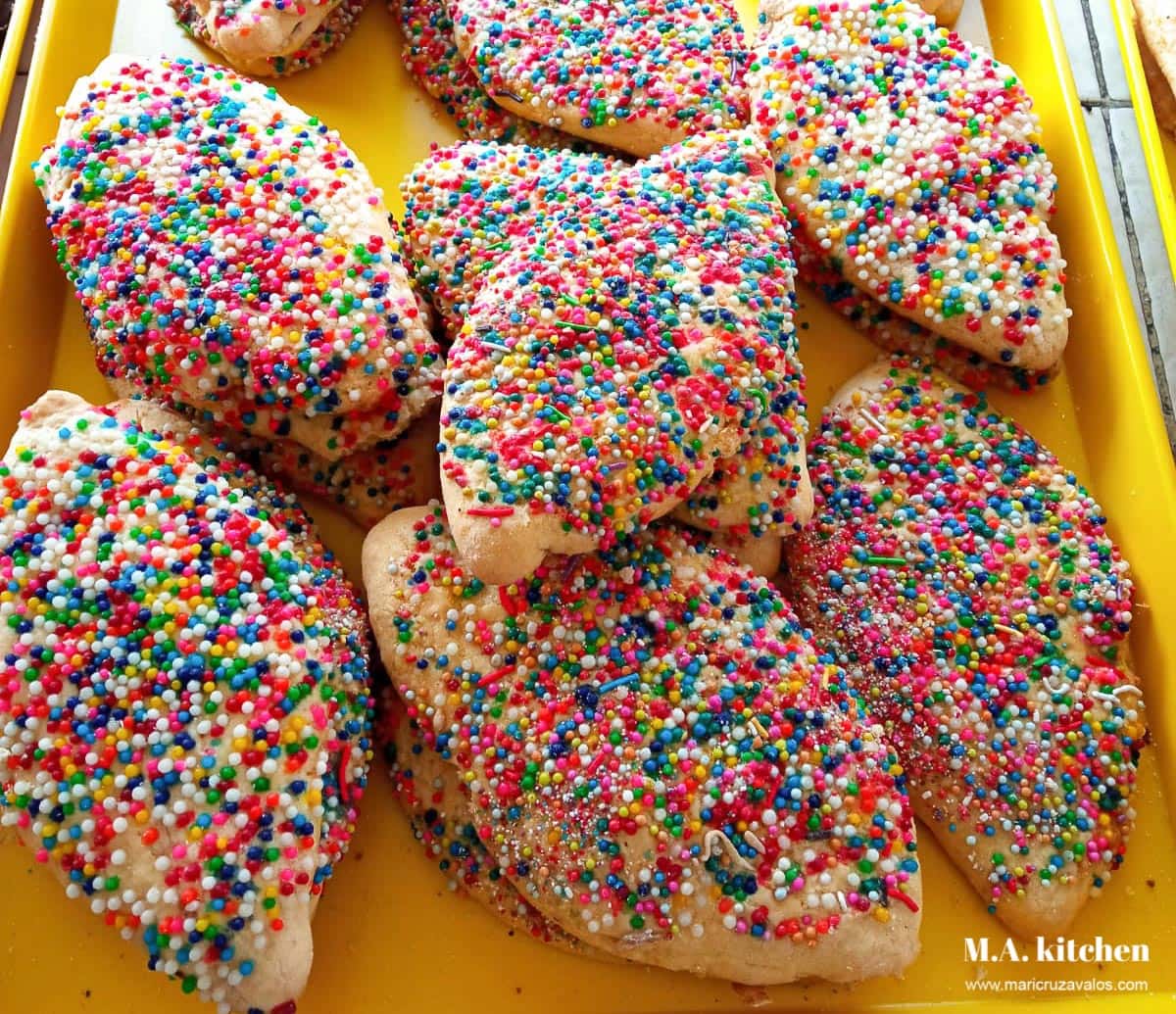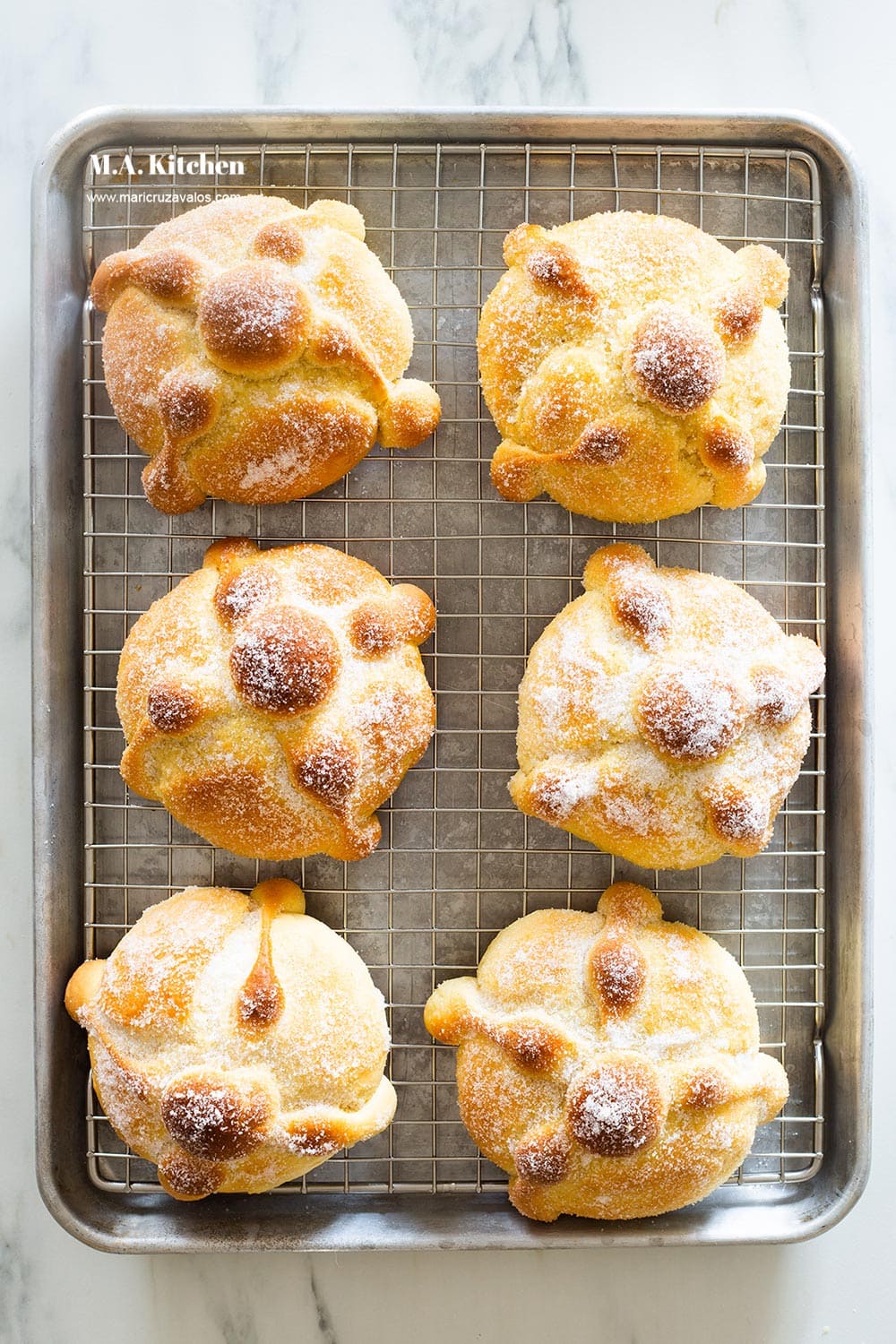This small guide about Mexican sweet bread (Pan Dulce) will walk you through and show you why this type of bread is a staple in Mexican gastronomy. So, grab a cup of coffee and enjoy it.
Pan dulce refers to the various types of Mexican sweet bread available in the country. They come in various shapes and flavors, being conchas one of the most popular recipes.
Origins
Before the arrival of the Spanish, wheat was not cultivated in Mexico. The preparation and consumption of bread originated after the arrival of Cortéz.
Once wheat arrived in Mexico, the country’s gastronomy was able to incorporate bread into its diet, becoming part of the culture.
The first pieces of bread were salty and it took a few years before the “pan dulce” made its appearance in Mexican bakeries due to the influence of French, Italian, and Spanish bakeries.

Types of Mexican Bread
There are certain types of pan dulce that cannot be missing in Mexican bakeries, let’s take a look at some of the most popular.
Concha: This modest but tasty bread is covered with patterns that resemble a seashell (Concha means seashell in Spanish), these covers can be made of chocolate, strawberry, or vanilla. Its fluffy texture is perfect for dipping into a cup of coffee or hot chocolate.

Cocol: The name of this bread comes from the Nahuatl cocolli, which means “the twisted one”. This flattened but soft-textured bread is one of the oldest and most traditional in Mexico. Sometimes it is covered with sesame seeds and its filling varies depending on the region.
Pan de canela: With a strong scent and cinnamon flavor, this soft bread has a cake texture and is perfect to serve as breakfast along with a glass of milk or with tea for an afternoon sweet snack.

Polvorones: A cookie-like pan dulce made in various shapes covered with sugar. The name comes from the word “polvo” (dust) because the texture is so crumbly that reminds of dust. The recipe is a variation of a Spanish cookie made with almond flour.

Rebanadas: Made with a thick slice of white loaf bread, and a spread of butter on a side.
Besos: The top and bottom of this bread seem to be kissing (beso) and it is the jam that produces this effect. The besos can be filled with apricot or strawberry jam and the bread is covered with sugar. This bread is also known as “ojo de buey” in some states.

Puerquito: Its “pig” shape is what gives it its name, it is one of the breads that have existed since colonial times. Its consistency is similar to a soft cookie and is prepared with piloncillo (cane sugar) and cinnamon. It has a chewy texture, perfect to be accompanied by a hot drink.
Panqué de Nuez: A Mexican pound cake made with pecan nuts and often topped with cajeta, it’s one of the various versions of soft pound cakes, being panqué de plátano another popular recipe.

Galletas de grageas: A thick cookie covered with sprinkles, its shape can vary, from round to square or even rhomboid. Even being a cookie, this type of “bread” is always present at any Mexican bakery.

Pan de polvo is another type of bread similar to a cookie. Its name means “dust bread” referring to its crumbly texture. It is made of a flavored sweet dough and has a nice anise flavor.
Seasonal Mexican Sweet Bread
Pan de muerto (bread of the dead): this famous sweet bread is only baked during the months of October and November and it is placed on the altars of the dead to remember loved ones who have already passed away. It has a subtle orange blossom flavor.

Rosca de reyes: The Rosca de Reyes is a tradition that originated in France. Later it arrived in Spain which spread it to Latin America. It is eaten in the month of January to celebrate the Epiphany.
This Mexican sweet bread is circular, like a ring, and it symbolizes the infinite love of God. Inside it, there are small plastic dolls that symbolize the baby Jesus.

Pan de Feria – Bread fair: These are various types of bread that are bought at “seasonal” fairs, usually when a patronal feast is being celebrated in some region. They are usually larger than the pan dulce found in bakeries, they can measure from 4 to 12- inches (10-30 cm) long.
Among the different types of pan de feria, you can usually find bread made with cream, decorated with sesame, walnuts, “ate” (a typical Mexican jam), or raisins.

Savory Types
And last but by no means least, we must make mention of the teleras, birote, and bolillos. Although they are more “salty” than sweet, these types of bread are never missing in Mexican bakeries.
Both breads are commonly used to accompany food, like any regular bread from around the world. They are also perfect for making traditional Mexican sandwiches and the traditional dessert for the Lent season, capirotada.

How To Eat
The Mexican sweet bread is mostly consumed at breakfast or as an afternoon snack accompanied by a delicious atole, hot chocolate café de olla, or milk. Is undoubtedly one of the most traditional ways that Mexicans consume this type of bread.
Also on certain special dates, some types of seasonal bread are consumed, these breads are only prepared in certain months of the year for cultural purposes, like the bread of the dead.

Where To Buy
Outside Mexico:

FAQ
What is Mexican sweet bread made of?
Mexican sweet bread is usually made of wheat flour, eggs, butter, vanilla extract, yeast, and sugar. Depending on the type and recipe, other ingredients are added like jam, cajeta caramel, nuts, etc.
What is the most popular bread in Mexico?
The most popular bread in Mexico is conchas, a soft and pillowy sweet bread covered with a streusel topping. It has a subtle vanilla taste and a brioche-like texture.
Video
After this sweet tour, there is nothing better than grabbing some atole, a cup of coffee, or a glass of milk and relaxing while savoring our favorite “pan dulce”.
If you liked this post about Mexican sweet bread, please take 1 minute to rate the recipe and leave a comment below. And remember to follow this blog on PINTEREST, INSTAGRAM, FACEBOOK, and YOUTUBE!



Love the explanation of sweet breads.